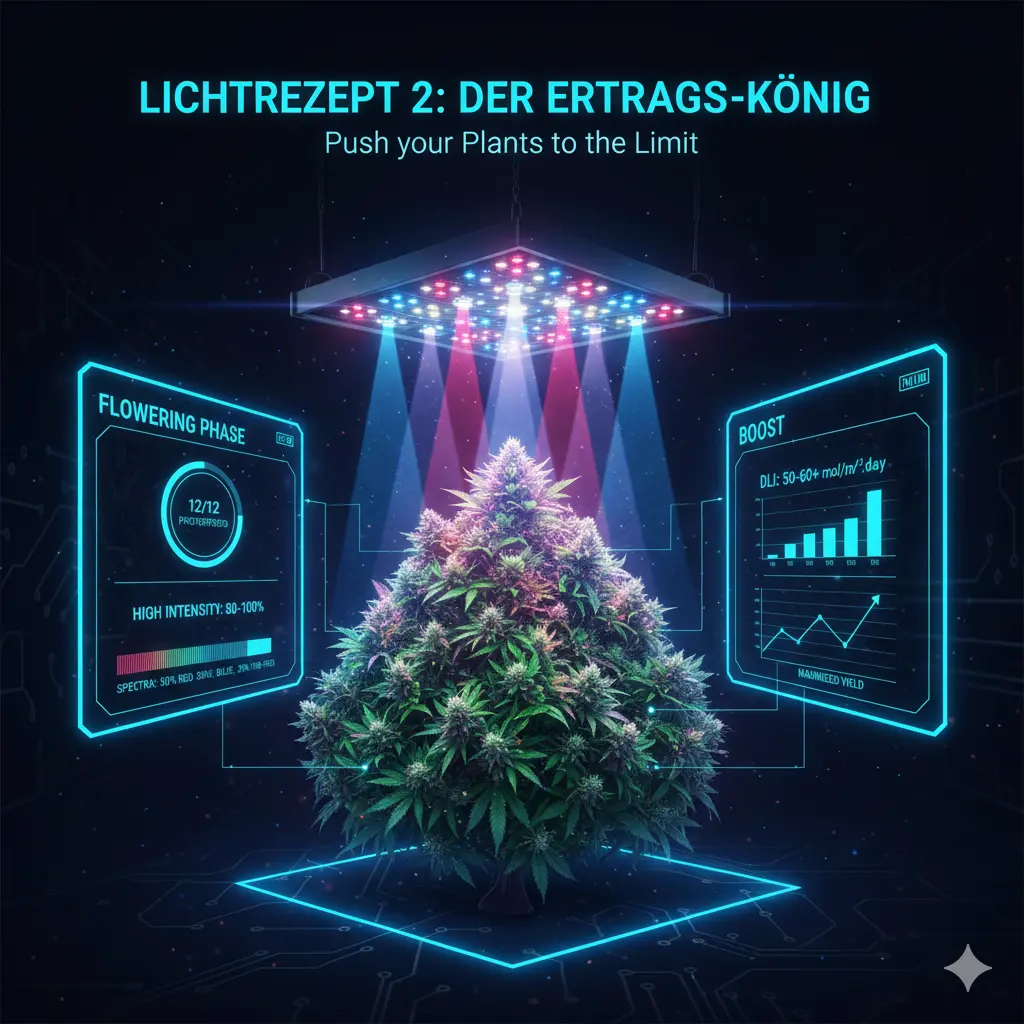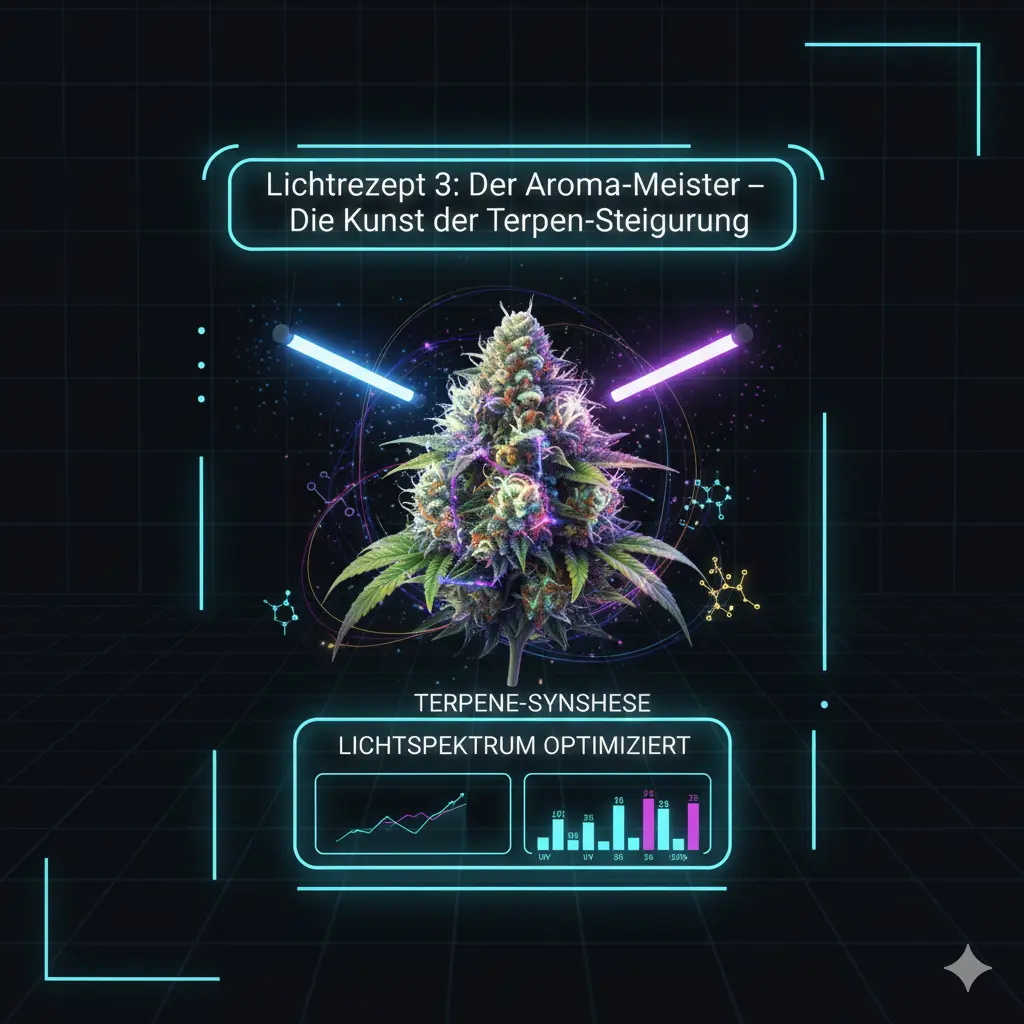What is a light recipe?
Imagine you were baking a cake: You wouldn’t just throw all the ingredients into the oven at the same time and set it to maximum temperature. In the same way, plants need different light “ingredients” throughout their life cycle – in the right quantity, with the right spectrum and at the optimum time.
This is the only way to achieve healthy growth, maximum photosynthesis and ultimately higher yields.
A light recipe is just that: a pre-defined, expert-supported plan that automatically determines how your plant lamp works every day. It not only controls how bright the light is, but also its color (spectrum) and the daily rhythm of your plants – and saves you money in the process.
The components of a lighting recipe: more than just on and off
A good lighting recipe is like a symphony. Each instrument plays a decisive role in the overall result.
1. intensity (brightness):
What it is: How strong (in percent) your lamp lights up.
Why it’s important: Young seedlings burn at 100% power, while flowering plants need this intensity to form thick, dense buds. One recipe perfectly regulates the strength for each growth phase.
2. spectrum (light color):
What it is: The color of the light that is emitted. Blue light promotes vegetative growth, red light triggers flowering.
Why it’s important: Modern LED lamps can adjust their spectrum. A recipe switches between “Grow” (more blue) and “Bloom” (more red) mode at the perfect time to control the desired plant response.
3rd photoperiod (length of day):
What it is: How many hours per day the light is switched on (e.g. 18h for the vegetative phase, 12h for flowering in photoperiodic plants).
Why it’s important: This is the crucial signal for the plant to grow or flower. Autoflowers often thrive under long 18-20h cycles.
4. sunrise & sunset (Sunrise/Sunset):
What it is: A gentle, gradual increase and decrease in light intensity at the beginning and end of each “day”.
Why it’s important: This mimics nature and prevents stress in plants. It can also stimulate metabolism and boost terpene production, which makes for better flavors.
All these components are controlled in a user-friendly app. A light recipe is the intelligent way to grow. It combines the art of growing plants with the science of lighting control and the economics of energy efficiency. You no longer have to choose between top results and high electricity bills. With light recipes, you can have both.
Recipe 1: Balanced cultivation – a solid basis
The perfect choice for: Beginners or anyone looking for a reliable, uncomplicated approach to photoperiodic strains.
Your reliable all-rounder: it provides a steady and moderate light schedule that keeps your plants growing healthily and consistently from seedling to harvest, without pushing them to their limit. It’s the safe bet for a great result.
Perfect for: Photoperiodic strains.
Recipe 2: The Yield King – Maximize your harvest
The perfect choice for: Growers who want to harvest the maximum number of dense, heavy buds.
What it does: This recipe is like a personal trainer for your plants. It uses an aggressive, high-intensity light push in the critical last weeks of flowering. This forces the plants to put all their energy into bud production – for the best possible yield.
Perfect for: Photoperiodic strains – #1 place for harvest size.
Recipe 3: The aroma master – unleash the full flavor
The perfect choice for: The connoisseur. If taste, smell and top quality are your top priorities, this is your recipe.
What it does: This recipe focuses on prolonged exposure to UVA light. This gentle stress signals the plant to produce more terpenes. The result? Buds that are incredibly aromatic, flavorful and complex.
Perfect for: Photoperiodic strains. Place #1 for terpenes
Recipe 4: The reliable one – Growe constant and carefree
The perfect choice for: Beginners or growers who prefer an alternative, low-risk approach that minimizes the risk of light stress.
What it does: Patience and stability are at its heart. It uses a gentle increase in light intensity and provides a stable environment for your plants to grow at their own pace. It’s the definition of “set it and forget it”.
Perfect for: Photoperiodic strains.
Recipe 5: Autoflower – Fast & aromatic
The perfect choice for: Anyone who grows autoflowering seeds and doesn’t want to sacrifice speed for quality.
What it does: Specially designed for the needs of autoflowers, this recipe utilizes a daily photoperiod of 18 hours and a very long, gradual sun cycle. This mimics nature and boosts the plant’s metabolism throughout its life cycle.
Perfect for: Autoflowering strains
 Treez Tools Grow Tent Black (L) – The Ultimate 3-in-1 Solution for Maximum Indoor Yields 120x120x200cm
1 × 109,99 €
Treez Tools Grow Tent Black (L) – The Ultimate 3-in-1 Solution for Maximum Indoor Yields 120x120x200cm
1 × 109,99 € Treez Tools Grow Light LED 320W PRO – Energy-efficient full-spectrum LED plant lamp
1 × 249,99 €
Treez Tools Grow Light LED 320W PRO – Energy-efficient full-spectrum LED plant lamp
1 × 249,99 € Treez Tools powered by Bilberry Smart Grow Light 160W
1 × 499,99 €
Treez Tools powered by Bilberry Smart Grow Light 160W
1 × 499,99 € Treez Tools powered by Bilberry Smart Grow Light 340W
2 × 729,99 €
Treez Tools powered by Bilberry Smart Grow Light 340W
2 × 729,99 € Treez Tools Grow Tent Black (M) – The Ultimate 3-in-1 Solution for Maximum Indoor Yields 100x100x200cm
2 × 94,99 €
Treez Tools Grow Tent Black (M) – The Ultimate 3-in-1 Solution for Maximum Indoor Yields 100x100x200cm
2 × 94,99 € Treez Tools powered by Bilberry Smart Grow Light 650W
2 × 1.229,99 €
Treez Tools powered by Bilberry Smart Grow Light 650W
2 × 1.229,99 € Treez Tools Grow Light LED 700W PRO – Energy-efficient full-spectrum LED plant lamp
2 × 549,99 €
Treez Tools Grow Light LED 700W PRO – Energy-efficient full-spectrum LED plant lamp
2 × 549,99 € Treez Tools Grow Light LED 500W PRO – energy-efficient full-spectrum LED plant lamp
3 × 449,99 €
Treez Tools Grow Light LED 500W PRO – energy-efficient full-spectrum LED plant lamp
3 × 449,99 €


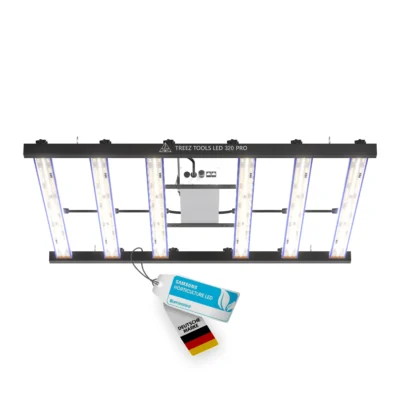 Treez Tools Grow Light LED 320W PRO – Energy-efficient full-spectrum LED plant lamp
Treez Tools Grow Light LED 320W PRO – Energy-efficient full-spectrum LED plant lamp  Treez Tools powered by Bilberry Smart Grow Light 160W
Treez Tools powered by Bilberry Smart Grow Light 160W  Treez Tools powered by Bilberry Smart Grow Light 340W
Treez Tools powered by Bilberry Smart Grow Light 340W 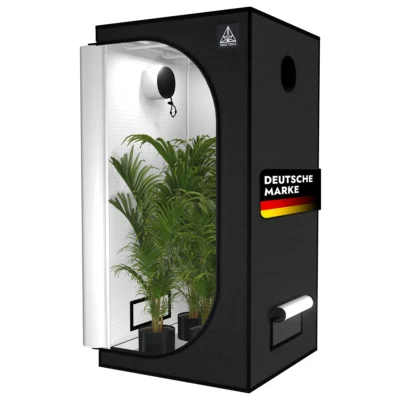 Treez Tools Grow Tent Black (M) – The Ultimate 3-in-1 Solution for Maximum Indoor Yields 100x100x200cm
Treez Tools Grow Tent Black (M) – The Ultimate 3-in-1 Solution for Maximum Indoor Yields 100x100x200cm  Treez Tools powered by Bilberry Smart Grow Light 650W
Treez Tools powered by Bilberry Smart Grow Light 650W 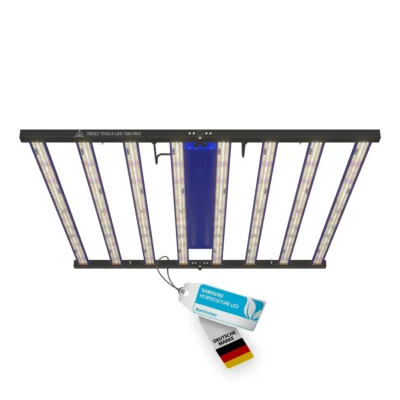 Treez Tools Grow Light LED 700W PRO – Energy-efficient full-spectrum LED plant lamp
Treez Tools Grow Light LED 700W PRO – Energy-efficient full-spectrum LED plant lamp 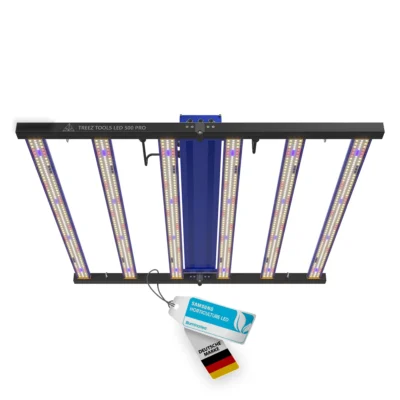 Treez Tools Grow Light LED 500W PRO – energy-efficient full-spectrum LED plant lamp
Treez Tools Grow Light LED 500W PRO – energy-efficient full-spectrum LED plant lamp 
